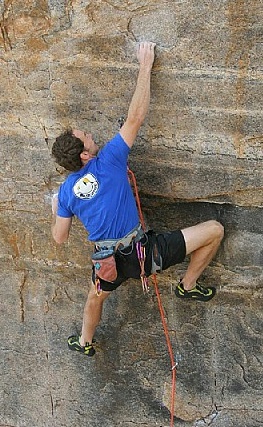Developing "Limit" Strength
 Good technique and a positive attitude are important attributes for climbing success, but sometimes you just need to be stronger. You know what I mean...those wicked cruxes where you just need to make a sick lock-off and reach...or sometimes you just need to stick a single heinous pocket or sloper to make a move. Your performance constraint in these situations is likely your "limit" strength.
Good technique and a positive attitude are important attributes for climbing success, but sometimes you just need to be stronger. You know what I mean...those wicked cruxes where you just need to make a sick lock-off and reach...or sometimes you just need to stick a single heinous pocket or sloper to make a move. Your performance constraint in these situations is likely your "limit" strength.In terms of training limit strength--your ability to pull a single maximal move or grip a small edge or pocket under full body weight--it is widely accepted by sports scientists that exercising at high intensity and heavy loads is the most important factor. Furthermore, the muscles must be progressively loaded beyond the point to which they are accustomed. In the weight-lifting world, this is achieved by performing 5 to 10 repetitions (or less) at a high load, which is increased over time. Unfortunately, this is a difficult protocol to create for the purpose of developing finger strength for climbing. For instance, what can you do to create progressive overload of the fingers (forearm muscles) once you are strong enough to handle your own bodyweight over steep terrain? The obvious answer is to "climb longer", which is exactly what many climbers do. However, this strategy of increasing training volume develops endurance of strength (i.e. anaerobic endurance), not maximum strength.
Bouldering as Training
A better strategy is to seek out progressively more strenuous boulder problems that seem to require near maximum limit strength. The drawback here is that it's very difficult to say if you fell off a move because of muscular failure or because you performed the movement poorly (bad technique). Further diluting the training effect is the random size and shape of the handholds which dictate use of different grip positions--we now know that varying grip position is a good endurance strategy, but it is poor for building maximum grip strength. The bottom line: while you will acquire some gains in strength and power from bouldering, you can be sure that it's not providing you with the greatest strength gains possible. There are just too many variables involved in outdoor bouldering.
Bouldering on a steep artificial wall represents a better format for upper-body strength training because you can control the size and distance between holds, and minimize the technical aspects that might spit you off before muscular failure. Still, there are practical limits as to how far you can increase hold spacing and decrease the size of the hand holds--beyond a certain point the moves will become overly technical or the tiny holds too painful to climb on until muscular failure. As described above, it's necessary to perform 5 to 10 maximum repetitions before reaching muscular failure (for the purpose of developing maximum strength), or in the case of climbing with both hands you would need to perform 10 to 20 total hand movements before failure.
Hypergravity Training
Once the above strategies have been exhausted for the purpose of developing further gains in limit strength, you need to up the ante by employing hypergravity training. At advanced levels of training for climbing, the importance of training at progressively higher intensity and with heavier loads can not be overstated. This is best achieved by adding extra weight to your body while performing certain controlled, sport-specific movements; for example, weighted pull-ups, weighted fingerboard hangs, weighted bouldering, and Hypergravity Isolation Training (HIT). This training strategy exposes your fingers (and other upper body "pull muscles") to a load and intensity not previously experienced at normal bodyweight. The extra weight simulates a greater-than-normal gravitational pull (hence the term "hypergravity"). After a period of hypergravity training, you will return to the rock at bodyweight and feel like you are climbing on the moon!
Eric Horst onsighting The Green Ripper (5.12b), Mt. Lemmon, AZ. Courtesy: EricMcCallister.com
Physiological Notes
Rate of strength gains, as a result of training, decrease as a function of your current level of strength. Therefore, initial (often dramatic) increases in strength will result from even a poorly conceived and executed training regimen. Adaptations in stronger, more advanced climbers occur more slowly and, possibly, not at all unless they are using the best training methods. This helps explain why so many intermediate to advanced climbers feel they are no longer getting stronger--for them, further gains require advanced training techniques and the discipline to apply them precisely over a long period of time.
The dramatic gains in strength produced by hypergravity training are the result of neural and muscular adaptations. In particular, it likely triggers a higher degree of disinhibition and hypertrophy that may never result from climbing at lower resistances (i.e. body weight). I also suspect that hypergravity training may trick slow-twitch muscle fibers into acting like fast-twitch fiber-more on this later. Obliviously, hypergravity training is an advanced strength training method to be used only by well-conditioned and advanced climbers with no recent history of injury. You can learn more on this and other cutting-edge training techniques in my book, Training For Climbing.



 Subscribe to Eric's RSS Feed
Subscribe to Eric's RSS Feed
 Subscribe to Eric's RSS Feed
Subscribe to Eric's RSS Feed